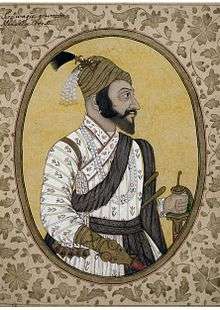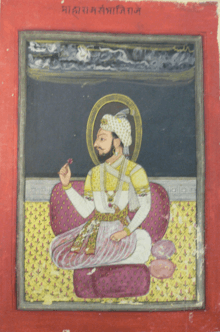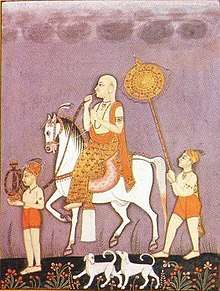Maratha emperors
| Chhatrapati of | |
|---|---|
 Shivaji | |
| Details | |
| Style | His Imperial Majesty |
| First monarch | Shivaji |
| Last monarch | Shivaji III |
| Formation | 1674 |
| Abolition | 1818 |
| Residence | Raigad fort |
| Appointer | Hereditary |
The Maratha emperors, belonging to the Bhonsale dynasty, from the early 17th century to the early 18th century, built and ruled the Maratha Empire on the Indian subcontinent, mainly corresponding to the modern countries of Bangladesh, India and Pakistan. [1] [note 1]) Their power rapidly dwindled during the 19th century and the last of the emperors was deposed in 1818, with the establishment of the British Raj. At their empire's greatest extent in the late 17th and early 18th centuries, they controlled much of the Indian subcontinent, extending from Bengal in the east to Atak and Sindh in the west, Kashmir in the north to the Kaveri basin in the south. Peshwas served as subordinates to the Chhatrapati (the Maratha king), but later, they became the leaders of the Marathas, and the Chatrapati was reduced to a nominal ruler. During the last years of the Maratha Empire, Peshwe were instrumental in expanding the Maratha empire to this extent. [3][4][5]
List of Maratha Emperors
| Portrait | Titular Name | Birth Name | Birth | Reign | Death | Notes |
|---|---|---|---|---|---|---|
 |
Shivaji | 6 April 1627 | 6 June 1674 – 3 April 1680
5 years 9 months |
3 April 1680 (aged 53) | Shivaji was a Maratha aristocrat of the Bhosle clan who is considered to be the founder of the Maratha empire. | |
 |
Sambhaji | May 14, 1657 | January 16, 1681- March 11, 1689
9 years 4 months 21 days |
Sambhaji had himself crowned and resumed his father's expansionist policies. Sambhaji had earlier defeated the Portuguese and Chikka Deva Raya of Mysore. | ||
| Rajaram I | 24 February 1670 | 12 March 1689 – 3 March 1700
11 years |
||||
 |
Chhattrapati Shahu | 18 May 1682 | 12 January, 1708 – 15 December, 1749
41 years |
15 December, 1749 | This started Satara branch | |
| Rajaram II of Satara | June 1726 | December 15, 1749 - December 11, 1777
28 years |
December 11, 1777 | Satara branch | ||
| Shahu II of Satara | 1763 | 11 Dec 1777 – 3 May 1808
31 years |
3 May 1808 | Satara branch | ||
 |
Pratap Singh, Raja of Satara | 18 January 1793 | 3 May 1808 - 5 September 1839
(31 years) |
5 September 1839 | He was the nominal emperor of the Maratha Empire, Satara from 1808 to 1819 and Raja of Satara but the main control was under the hands of Peshwas until 1839 when he was deposed by the British. Satara branch | |
 |
Tarabai | 1675–1761
6 years |
1761 | She was wife of Chhatrapati Rajaram) in the name of her son Shivaji II under the Maratha empire of Kolhapur branch. | ||
| Shivaji II | 1698 | 1700-1707, 1710-1714
11 years |
He was son of Maratha ruler Chhattrapati Rajaram and his wife Tarabai of Kolhapur branch | |||
| Sambhaji II | 1714 to 1760
46 years |
He came to power by deposing his half brother Shivaji II | ||||
| Shivaji III | 1760–1812
52 years |
He adopted from the family of Khanwilkar which was from Kolhapur branch | ||||
See also
References
- ↑ An Advanced History of Modern India By Sailendra Nath Sen, p.16
- ↑ Bharatiya Vidya Bhavan, Bharatiya Itihasa Samiti, Ramesh Chandra Majumdar – The History and Culture of the Indian People: The Maratha supremacy
- ↑ Pearson, M. N. (February 1976). "Shivaji and the Decline of the Mughal Empire". The Journal of Asian Studies. 35 (2): 221–235. doi:10.2307/2053980. JSTOR 2053980. (Subscription required (help)).
- ↑ Delhi, the Capital of India By Anon, John Capper, p.28. "This source establishes the Maratha control of Delhi before the British"
- ↑ An Advanced History of Modern India By Sailendra Nath Sen p.Introduction-14. The author says: "The victory at Bhopal in 1738 established Maratha dominance at the Mughal court"